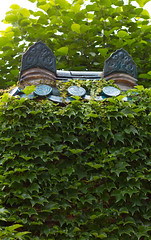Could we make our towns and cities cooler (and obviously greener) by smothering them with growing plants?
This is already being done, albeit on a very small scale, and to positive effect. Green roofs, especially, are becoming features of new buildings being built to high eco-specification, such as the Royal Botanic Gardens in Edinburgh and the BBWNT visitor centre at College Lake, Bucks.
Helen Knight, writing in New Society (Green Machine) notes that green roofs help reduce the “heat island” effect in towns and cities, because plants absorb less heat than concrete and can also cool the air via the process of evapotranspiration. This can save energy by cutting the need for air conditioning on hot days. What’s more, roofs reduce the risk of flooding by absorbing water and, of course, they absorb carbon dioxide.”
Photo – Symic
Most existing green roofs use various species of Sedum, plants that can survive without rain for long periods, so that they require little maintenance.
However Tijana Blanusa, a Royal Horticultural Society researcher at the University of Reading in the UK, wasn’t convinced that Sedum is the best plant for the job.
She compared a variety of plants, including a Sedum mix, lamb’s ear and elephant ear, to see if differences in leaf shape and structure would make a difference to the temperature of the air above them.
In the study lamb’s ear, a silvery, hairy-leafed plant, had the consistently coolest leaves over a two-year period, keeping its leaves cooler than those plants that don’t have hairs.
She measured the air temperature 20 centimetres above each plant and found that on the hottest summer afternoons the air above lamb’s ear was cooler than above the other plants.
She presented her findings at the World Green Roof Congress in London (September 15, 2010) .
Looking at the same problem, US ecologist Mark Simmons at the University of Texas at Austin found that sedum did not perform well in cities like Austin, Texas, that are hot and prone to flash floods.
He compared six “green roofs” in Austin, planted with a range of species, and found that the city’s mix of long bouts of heavy rain followed by periods of drought caused Sedum to rot. While all the plants he tested tended to cool the air around them, grasses such as big bluestem and maize performed best at absorbing rainwater.

